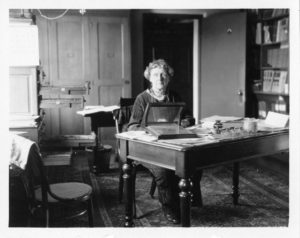Guest post by Sue Bowler, for the Royal Astronomical Society, Platinum Sponsor of Ada Lovelace Day Live 2016.
Continuing with their series of articles on early women members of the Royal Astronomical Society published in Astronomy and Geophysics, Sue Bowler discusses the contributions of Williamina Fleming and Annie Jump Cannon in photographic astronomy.

Annie Jump Cannon at Harvard College Observatory (Smithsonian Institution Archives)
Towards the end of the nineteenth century, Harvard College Observatory employed a team of women to analyze the spectra of stars, an endeavour that resulted in the standard classification scheme for stars, still used today. Williamina Fleming, Annie Jump Cannon and Henrietta Leavitt stand out among the ‘Harvard computers’, so named because their work was to carry out the many repetitive calculations necessary for scientific astronomy.
Edward Pickering was the Director of Harvard College Observatory at a time when the new field of photographic astronomy required careful measurement of the position of stars and their spectra on large glass plates. The role of computer was a lowly one, and it paid very poorly, lower than a factory girl’s wage. But it appealed to educated women, often the products of the new colleges such as Vassar and Wellesley that taught the sciences and even astronomy.

Williamina Fleming (The New England magazine (1887), p. 166).
Annie Jump Cannon was among those who came to Harvard as a computer, attracted by a role that offered employment and scientific stimulation. She developed a spectral classification system adopted by the International Astronomical Union in 1922 and ended her career at Harvard as a world-renowned astronomer.
Cannon’s work built on that of Williamina Fleming, a married woman from Scotland abandoned by her husband in America. She was Pickering’s housekeeper before working at the Observatory and, as well as considerable achievements in observational astronomy and spectral classification of stars, she organized the computers, in a role we would now recognize as something between office manager and head of a research group.
Both Fleming and Cannon were made honorary members of the RAS before women could become Fellows. Their work has lasted, demonstrating the contribution that women could make at a time when astronomy in the US was becoming a profession as well as an interest.
You can read more about Annie Jump Cannon in the journal Astronomy and Geophysics, and Sue Nelson wrote about Williamina Fleming for Astronomy and Geophysics, a longer version of which is also in our book, A Passion for Science.
Bowler, S. (2016), “Annie Jump Cannon, stellar astronomer”, Astronomy & Geophysics, 57(3) 3.14-3.15.